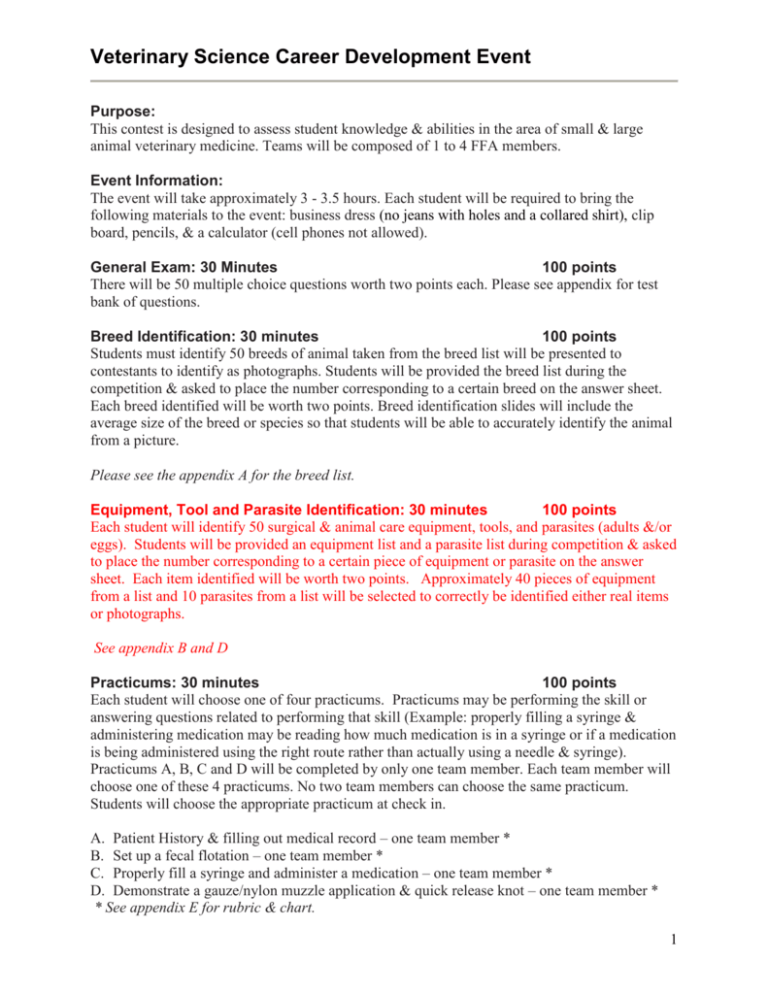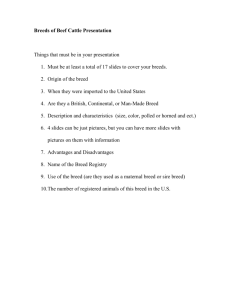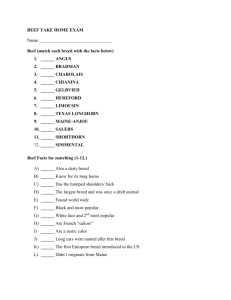File - Saline FFA Ag Skills
advertisement

Veterinary Science Career Development Event Purpose: This contest is designed to assess student knowledge & abilities in the area of small & large animal veterinary medicine. Teams will be composed of 1 to 4 FFA members. Event Information: The event will take approximately 3 - 3.5 hours. Each student will be required to bring the following materials to the event: business dress (no jeans with holes and a collared shirt), clip board, pencils, & a calculator (cell phones not allowed). General Exam: 30 Minutes 100 points There will be 50 multiple choice questions worth two points each. Please see appendix for test bank of questions. Breed Identification: 30 minutes 100 points Students must identify 50 breeds of animal taken from the breed list will be presented to contestants to identify as photographs. Students will be provided the breed list during the competition & asked to place the number corresponding to a certain breed on the answer sheet. Each breed identified will be worth two points. Breed identification slides will include the average size of the breed or species so that students will be able to accurately identify the animal from a picture. Please see the appendix A for the breed list. Equipment, Tool and Parasite Identification: 30 minutes 100 points Each student will identify 50 surgical & animal care equipment, tools, and parasites (adults &/or eggs). Students will be provided an equipment list and a parasite list during competition & asked to place the number corresponding to a certain piece of equipment or parasite on the answer sheet. Each item identified will be worth two points. Approximately 40 pieces of equipment from a list and 10 parasites from a list will be selected to correctly be identified either real items or photographs. See appendix B and D Practicums: 30 minutes 100 points Each student will choose one of four practicums. Practicums may be performing the skill or answering questions related to performing that skill (Example: properly filling a syringe & administering medication may be reading how much medication is in a syringe or if a medication is being administered using the right route rather than actually using a needle & syringe). Practicums A, B, C and D will be completed by only one team member. Each team member will choose one of these 4 practicums. No two team members can choose the same practicum. Students will choose the appropriate practicum at check in. A. Patient History & filling out medical record – one team member * B. Set up a fecal flotation – one team member * C. Properly fill a syringe and administer a medication – one team member * D. Demonstrate a gauze/nylon muzzle application & quick release knot – one team member * * See appendix E for rubric & chart. 1 Scoring: Individual & team scores will be calculated for the event. The individual score will be calculated as follows: General Exam Breed Identification Equipment, Tool and Parasite Identification Practicum Total Points 100 points 100 points 100 points 100 points 400 points In event of an individual tie, the placing will be determined by the general exam score, the breed identification score, & the first practicum score in that order. The team score will be calculated as follows: Three top individual scores @ 400 points 1200 points References: The following are suggested references to use in preparation for this CDE. Veterinary Medicine Veterinary Assistant: Fundamentals & Applications by Beth Vanhorn & Robert W. Clark – Delmar Publishing 2011. Principles & Practice of Veterinary Technology by Paul W. Pratt The Merck Veterinary Manual – Merck & Co. or http://www.merckvetmanual.com/ Veterinary Science Teachers Guide – Team Ag Ed & Cornell Educational Resources Program, 2003. (CDROM) Parasitology Identification Tutorial-- http://cvm.msu.edu/courses/mic569/docs/parasite/ Veterinary Medical Terminology by Dawn Christenson Veterinary Surgical Instruments-- http://207.62.207.35/vet01/vett53a/vett53Anotes/notes03a.htm Small Animal Care Small Animal Care & Management by Dean M. Warren, Delmar Publishing Small Animal Handling & Restraint Handbook Introduction to Livestock and Companion Animals –Interstate Publishing Large Animal Care Agripedia—University of Kentucky-- http://www.ca.uky.edu/Agripedia/ Handbook of Livestock Management by Richard A. Battaglia Modern Livestock & Poultry Production by James R. Gillespie Breed References Breeds of Livestock—Oklahoma State University-- http://www.ansi.okstate.edu/breeds/ American Kennel Club – The Complete Dog Book & www.akc.org Cat Fanciers Association – www.cfa.org American Rabbit Breeders Association – www.arba.net American Cavy Breeders Association – www.acbaonline.com Anatomy and Physiology Introduction to Veterinary Science – Delmar Dog & Cat Anatomy Flashcards – www.bryanedwards.com Revised March 2012 2 Appendix A: Breed List Dogs: 1. Basset Hound 2. Beagle 3. Border Collie 4. Boxer 5. Bulldog 6. Chihuahua 7. Chinese Shar-Pei 8. Cocker Spaniel 9. Collie 10. Dachshund 11. Doberman Pinscher 12. English Setter 13. German Shepherd Dog 14. German Shorthaired Pointer 15. Golden Retriever 16. Great Dane 17. Great Pyrenees 18. Greyhound 19. Labrador Retriever 20. Maltese 21. Miniature Schnauzer 22. Pembroke Welsh Corgi 23. Pomeranian 24. Poodle 25. Pug 26. Rottweiler 27. Saint Bernard 28. Shih Tzu 29. Siberian Husky 30. Yorkshire Terrier Cats: 1. Abyssinian 2. American Shorthair 3. Bengal 4. Birman 5. Burmese 6. Cornish Rex 7. Maine Coon 8. Manx 9. Persian 10. Scottish Fold 11. Siamese 12. Turkish Angora Rabbits: 1. Californian 2. Dutch 3. English Angora 4. Flemish Giant 5. Himalayan 6. Jersey Wooly 7. Mini Lop 8. Mini Rex 9. Netherland Dwarf 10. Polish 11. Satin 12. New Zealand 13. Tan Pocket Pets: 1. Abyssinian (Guinea Pig) 2. American (Guinea Pig) 3. Peruvian (Guinea Pig) 4. Texel (Guinea Pig) 5. Chinchilla 6. Hamster 7. Gerbil 8. Degus 9. Ferret 10. Hedgehog 11. Mouse 12. Rat Equine: 1. Appaloosa 2. Arabian 3. Belgian 4. Clydesdale 5. Haflinger 6. Miniature Horse 7. Morgan 8. Donkey 9. Paint 10. Percheron 11. Quarter Horse 12. Standardbred (w/cart) 13. Tennessee Walker 14. Thoroughbred (w/ jockey or saddle) 3 Dairy Cattle 1. Ayrshire 2. Brown Swiss 3. Guernsey 4. Holstein 5. Jersey 6. Milking Shorthorn Beef Cattle 1. Angus 2. Belted Galloway 3. Brahman 4. Charolais 5. Hereford 6. Limousin 7. Maine-Anjou 8. Texas Longhorn 9. Shorthorn 10. Simmental 11. Scottish Hilander Swine 1. 2. 3. 4. 5. Berkshire Chester White Duroc Hampshire Landrace 6. Poland China 7. Spotted 8. Yorkshire Sheep 1. Cheviot 2. Columbia 3. Dorset 4. Hampshire 5. Montendale 6. Merion 7. Jacob 8. Rambouillet 9. Southdown 10. Suffolk Goats 1. Alpine 2. Boer 3. LaMancha 4. Nubian 5. Pygmy 6. Saanens 7. Toggenburg 8. Angora 9. Oberhase 4 Appendix B: Parasite Identification & Disease List Parasite Identification (Adults & Eggs) 1. Bots 2. Coccidia 3. Dipylidium Tapeworm (Flea tapeworm) 4. Fleas 5. Giardia 6. Hookworm 7. Heartworm microfilaria 8. Heartworms 9. Lice 10. Liver Fluke 11. Mites 12. Roundworm 13. Strongyles 14. Taenia Tapeworm 15. Ticks 16. Whipworm 5






